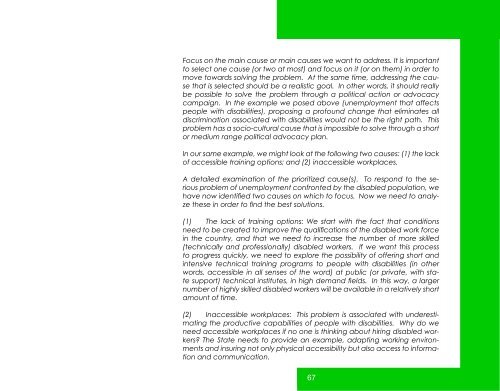in English - Handicap International
in English - Handicap International
in English - Handicap International
Create successful ePaper yourself
Turn your PDF publications into a flip-book with our unique Google optimized e-Paper software.
Focus on the ma<strong>in</strong> cause or ma<strong>in</strong> causes we want to address. It is important<br />
to select one cause (or two at most) and focus on it (or on them) <strong>in</strong> order to<br />
move towards solv<strong>in</strong>g the problem. At the same time, address<strong>in</strong>g the cause<br />
that is selected should be a realistic goal. In other words, it should really<br />
be possible to solve the problem through a political action or advocacy<br />
campaign. In the example we posed above (unemployment that affects<br />
people with disabilities), propos<strong>in</strong>g a profound change that elim<strong>in</strong>ates all<br />
discrim<strong>in</strong>ation associated with disabilities would not be the right path. This<br />
problem has a socio-cultural cause that is impossible to solve through a short<br />
or medium range political advocacy plan.<br />
In our same example, we might look at the follow<strong>in</strong>g two causes: (1) the lack<br />
of accessible tra<strong>in</strong><strong>in</strong>g options; and (2) <strong>in</strong>accessible workplaces.<br />
A detailed exam<strong>in</strong>ation of the prioritized cause(s). To respond to the serious<br />
problem of unemployment confronted by the disabled population, we<br />
have now identified two causes on which to focus. Now we need to analyze<br />
these <strong>in</strong> order to f<strong>in</strong>d the best solutions.<br />
(1) The lack of tra<strong>in</strong><strong>in</strong>g options: We start with the fact that conditions<br />
need to be created to improve the qualifications of the disabled work force<br />
<strong>in</strong> the country, and that we need to <strong>in</strong>crease the number of more skilled<br />
(technically and professionally) disabled workers. If we want this process<br />
to progress quickly, we need to explore the possibility of offer<strong>in</strong>g short and<br />
<strong>in</strong>tensive technical tra<strong>in</strong><strong>in</strong>g programs to people with disabilities (<strong>in</strong> other<br />
words, accessible <strong>in</strong> all senses of the word) at public (or private, with state<br />
support) technical <strong>in</strong>stitutes, <strong>in</strong> high demand fields. In this way, a larger<br />
number of highly skilled disabled workers will be available <strong>in</strong> a relatively short<br />
amount of time.<br />
(2) Inaccessible workplaces: This problem is associated with underestimat<strong>in</strong>g<br />
the productive capabilities of people with disabilities. Why do we<br />
need accessible workplaces if no one is th<strong>in</strong>k<strong>in</strong>g about hir<strong>in</strong>g disabled workers?<br />
The State needs to provide an example, adapt<strong>in</strong>g work<strong>in</strong>g environments<br />
and <strong>in</strong>sur<strong>in</strong>g not only physical accessibility but also access to <strong>in</strong>formation<br />
and communication.<br />
67

















